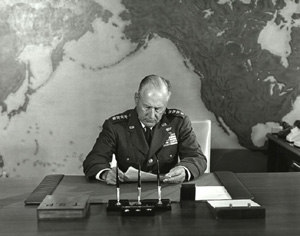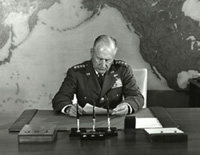U.S. War Plans Would Kill an Estimated 108 Million Soviets, 104 Million Chinese, and 2.3 Million Poles: More Evidence on SIOP-62 and the Origins of Overkill
Lieutenant General Thomas Power, Commander-in-Chief, Strategic Air Command, 1957-1964, and Director, Joint Strategic Target Planning Staff, 1960-1964, presided over the creation of SIOP-62 (Image, courtesy of Headquarters, U.S. Strategic Command)
A recently declassified Joint Chiefs of Staff report on “Berlin Contingency Planning,” produced in June 1961 as the Berlin Crisis was heating up, includes horrific estimates of fatalities and destruction that the execution of U.S. war plans would cause to the Soviet Union and putative allies. According to the JCS, if the full U.S. nuclear force assigned to the Single Integrated Operational Plan (SIOP) struck the Soviet Union, 54 percent of the total population would be killed, that is some 108 million of a total population of 217 million. If the smaller alert force (bombers on 15 minute to 2 hour alert) was used, total Soviet casualties would be 37 percent or about 80 million. Against China, the full force would kill a smaller proportion because there were fewer cities: 16 percent of an estimated 650 million or about 104 million.[1] Poland, the site of Soviet air defense installations, would suffer 2,636,000 million casualties in an attack by the full force. The report, sent to Secretary of Defense Robert McNamara, was forNational Security Adviser McGeorge Bundy to use for answering questions posed by White House adviser and former Secretary of State Dean Acheson.[2]
Total USSR casualties destroyed by US nuclear strike: 54 percent of total population.
The estimated fatalities would be caused by the implementation of the first SIOP (for fiscal year1962), which the Defense Department had created to consolidate Air Force, Navy, and Army nuclear war plans and to eliminate duplicate targets, among other problems. The terrible casualty figures were the direct consequence of standard operating procedures used by war planners. According to the JCS report, the SIOP-62 stipulated a 95 percent assurance factor for the destruction of targets “representing a direct threat” to the continental U.S. A very high assurance of destruction in Russia was considered to be essential to minimize the danger posed by Soviet forces to the continental United States. To meet the assurance criteria SIOP-62 posited a mass attack of an alert force of over 1700 nuclear weapons. Some Designated Ground Zeroes (DGZs) would be struck by 2 or more weapons, creating more devastating weapons effects (fires, blast, and radiation). The high degree of assurance is one of the bases of the “overkill” that was associated with U.S. nuclear war plans.[3]
The JCS report includes never before declassified details on major target categories that comprised the SIOP target list. 983 “nuclear threat” targets (bombers, missiles, nuclear storage), targets threatening “forward areas” (U.S. bases and allies in Western Europe, East Asia), “satellite air threat” (airfields and air to surface [possibly surface to air] missile storage), and “residual air and surface capability” (reserve airfields, air depots, etc.). According to the report not all of the 983 “installations” were targets for the alert force. For example, 230 airfields were reserved for attack by the full force only.
The JCS provided the details on nuclear threat targets in order to answer fully one of Acheson’s questions. To the query on how much of the Soviet Union’s strategic attack forces would be destroyed, the Joint Chiefs of Staff’s response was hardly encouraging: an estimated 42 percent of the total would suffer “severe damage” if the United States launched a preemptive attack. This left the Soviet Union with considerable retaliatory strength to impose massive destruction on the U.S. and allies.
Other SIOP targets mentioned by the JCS were command centers and cities. 103 “government control centers” in China and the Soviet Union were on the target list (over and above 23 other centers which were co-located with other targets); the preponderance was no doubt Soviet. The target list also included almost all Soviet cities with populations of 50,000 or greater. The alert force would target 199 cities, while the full force would target 295. The cities were included in the “urban-industrial” category and that the DGZs for a given city probably included several co-located installations (munitions factories, steel works, railroad yards, etc.). In these instances, the JSTPS probably used the “target island” concept to help plan strikes on adjacent military or industrial installations that were to be destroyed by striking a DGZ somewhere on the “island.”
This document gives us only a partial view of SIOP targeting. Not mentioned air defense targets which numbered 41, according to a message from Navy planners in Omaha. . The SIOP also covered Bravo or non-nuclear military targets. The same Navy document describes a merging of Alpha and Bravo target lists by the Joint Strategic Target Planning Staff, while the history ofSIOP-62 depicts a process of “optimum targeting” involving an “optimum-mix” list of the “best combination” of military and urban-industrial targets. Exactly what the “optimum mix” looked like is classified, but according to the Navy message, by late April 1961 the melding of Alpha and Bravo target categories for the alert force had produced a list of 725 DGZs including 41 air defense targets (20 of which were defenses of strategic nuclear targets). The 725 targets would be struck by 1706 weapons.[4]
What made this extraordinary JCS report available was a joint effort by the National Declassification Center at the National Archives and the CIA’s Historical Publications Office to declassify several hundred documents on the Berlin Crisis during the Eisenhower-Kennedy-Khrushchev years. The documents were released in conjunction with a conference on 27 October 2011, to commemorate the 50th anniversary of the Checkpoint Charlie tank confrontation, one of the major events of the 1961 crisis. The NDC and the CIA deserve a lot of credit for spearheading this effort and coordinating declassification of highly significant documents on a wide range of issues, including intelligence assessments, material obtained from clandestine sources, covert action planning, negotiating strategy, and politico-military contingency planning. Many of the documents have never been declassified or published before and researchers will find much of value.[5]
[1] . Fatality estimates have been declassified before (for example, this estimate from 1962), but this may be one of the first time that estimates specifically based on the SIOP have been released. It is worth noting that a few weeks earlier, Daniel Ellsberg, then working at the Pentagon, compiled an estimate of fatalities including deaths six months later, see Ellsberg, Secrets: A Memoir of Vietnam and the Pentagon Papers (New York: Viking, 2006), 58-59
[2]. President Kennedy must have gotten an inkling of what the SIOP had in store for Poland because during a meeting with the Joint Chiefs in January 1962 he asked for details. Theanswer, sent by JCS Chairman Lyman Lemnitzer, has not yet been declassified but it probably included a number for estimated casualties similar to the one cited above
[3].. For SIOP-62 see David A. Rosenberg, “The Origins of Overkill: Nuclear Weapons and American Strategy, 1945-1960,” International Security 7 (1983): especially 7-8 and 64-68. Rosenberg’s evidence suggests that the JSTPS sought assurances of as high as 97 percent to destroy the first 200 DGZs.
[5] . The CIA’s briefing package states that this is the “first time” publication of the State Department six-part history, Crisis Over Berlin, but it was declassified (except for a few lines in Part VI) by the Department in the early 1990s in response to a FOIA request. The National Security Archive subsequently published this history in William Burr, ed., The Berlin Crisis, 1958-1962 (1993) also available on the Digital National Security Archive.
http://en.wikipedia.org/wiki/Single_Integrated_Operational_Plan
http://www.jstor.org/discover/10.2307/2538916?uid=3739856&uid=2&uid=4&uid=3739256&sid=21103096313493
| For release 13 July 2004 |
For more information,
contact William Burr, 994-7032 |
|
U.S. Nuclear War Plans A Overkill Problem Led Top Commanders to Complain About the SIOP’s Destructiveness |
The U.S. included so many nuclear weapons in its first missile-age plan for nuclear war that top military commanders called it a “hazard to ourselves as well as our enemy,” according to newly declassified documents posted today by the National Security Archive at George Washington University.
Under the first Single Integrated Operational Plan, prepared during 1960, a Russian city the size of Nagasaki–devastated in 1945 with a twenty kiloton bomb–would receive three 80 kiloton weapons. President Dwight D. Eisenhower, then leaving office, along with Navy leaders and White House Science Adviser George Kistiakowsky, was deeply critical of the SIOP’s overkill. Eisenhower was later reported to have said that the plan “frighten[ed] the devil out of me.” Incoming Secretary of Defense Robert McNamara soon decried the “fantastic” levels of fallout that attacks on a multitude of Soviet targets would produce.
Ever since its creation, the SIOP has been one of the U.S. government’s deepest secrets. Even historical information about U.S. nuclear war plans has been hard to come by and documents once available become reclassified again. Today’s posting includes never before published as well as previously declassified key documents from 1959-1961 on the history of SIOP-62 (for fiscal year 1962). Among the disclosures in the documents:
- The SIOP included retaliatory and preemptive options; preemption could occur if U.S. authorities had strategic warning of a Soviet attack;
- A full nuclear SIOP strike launched on a preemptive basis would have delivered over 3200 nuclear weapons to 1060 targets in the Soviet Union, China, and allied countries in Asia and Europe;
- A full nuclear strike by SIOP forces on high alert, launched in retaliation to a Soviet strike, would have delivered 1706 nuclear weapons against a total of 725 targets in the Soviet Union, China, and allied states;
- Targets would have included nuclear weapons, government and military control centers, and at least 130 cities in the Soviet Union, China, and allies;
- Alarmed White House scientists, Army and Navy leaders were concerned that the SIOP would deliver too many nuclear weapons to Soviet and Chinese territory and that the weapons that missed targets “will kill a lot of Russians and Chinese” and that fallout from the weapons “can be a hazard to ourselves as well as our enemy”;
- According to the damage expectancy criteria of SIOP-62, it would take three 80 kiloton weapons to destroy a city like Nagasaki–which the U.S. had actually bombed with a 22 kiloton weapon;
- The Marine Corp commandant was concerned that the SIOP provides for the “attack of a single list of Sino-Soviet countries” and makes no “distinction” between Communist countries that were at war with the United States and those that were not;
- The Defense Department has overclassified and inconsistently released information about the SIOP.
Some evidence exists that after the Cold War ended, Strategic Air Command commander-in-chief General Lee Butler tried to curb what he saw as the SIOP’s “grotesque excesses” by paring down the huge target lists. Security classification, however, hides whether General Butler’s reforms took hold or whether the SIOP remains an instrument of overkill.
Go to the Electronic Briefing Book



